
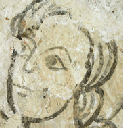
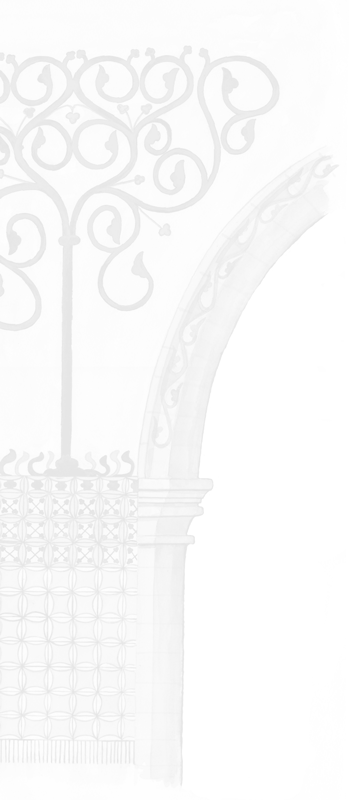
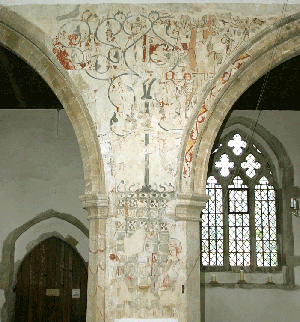

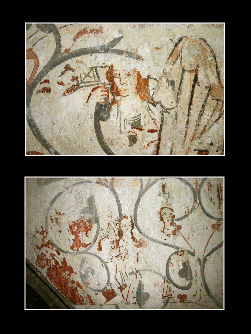
In the opening months of 1349 death came to Lakenheath. The Black Death, or ‘Pestilence’ as it was known at the time, had devastated southern England in the second half of the previous year. However, Suffolk had remained mercifully free of infection. Then, in the first days of January 1349, a new outbreak occurred. Most probably brought down the river from the port at Kings Lynn, the first place that the new outbreak gripped was Lakenheath itself. By May of that year over half the population of the parish appears to have perished. From Lakenheath it spread outwards to Brandon, Mildenhall and Ely - until the whole of north Suffolk and east Cambridgeshire was swept by pestilence. In the wake of such catastrophe a new world emerged.
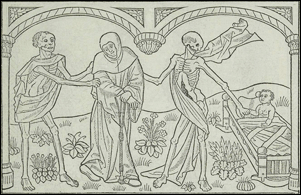
In the years immediately following the Black Death, and perhaps as a direct result, the church at Lakenheath received an entirely new paint scheme. The largely geometric designs that had accompanied the angels of the first scheme were white-washed over to be replaced with a multitude of figures and scenes that, in the wake of so much death, talked instead of rebirth and resurrection.
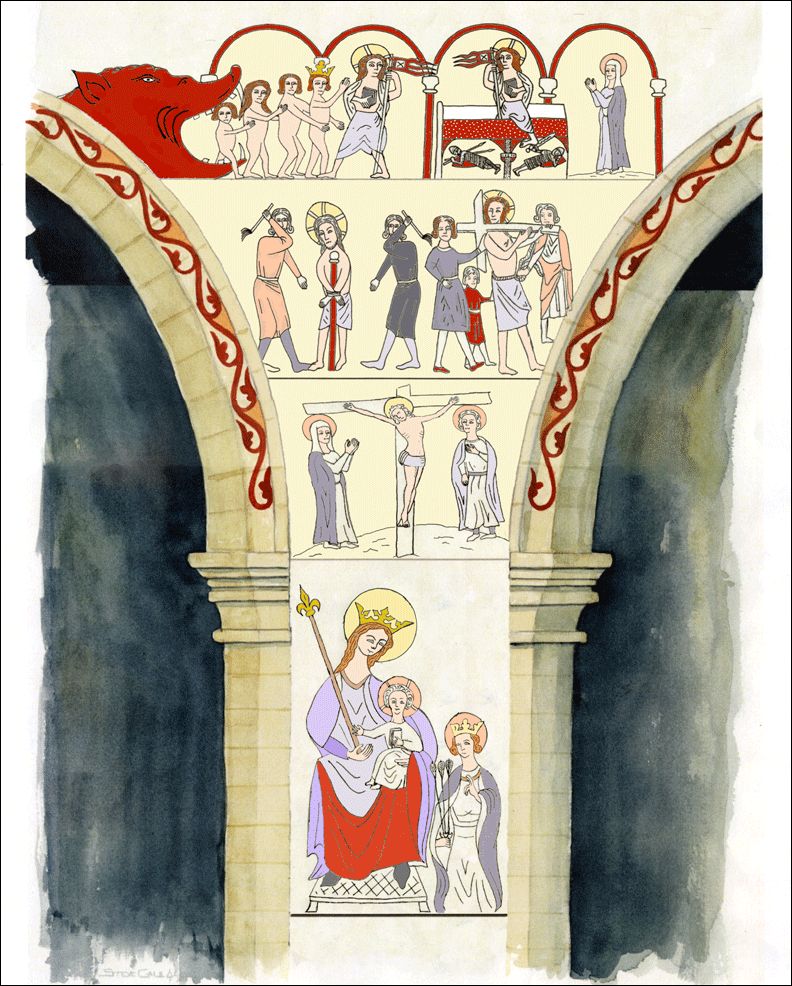
High up on the north arcade the angels, who had gazed down upon the congregation for well over a century, were finally covered over. In their place were painted a series of full length figures - saints and apostles - in a procession down the nave towards the altar and the chancel. Painted on only a few flimsy layers of limewash most of these figures were lost during the rediscovery and uncovering of the wall paintings. Only a few easily recognisable fragments survived the chisels of the 19th century. However, even these few fragments are enough to give us some indication of which saints were depicted.
A pair of eyes, the top of a head and fragment of a sword show that one of the figures was probably St Paul. Another fragment of a head, a hand and a pilgrims staff indicate that St James the Great was also present. Of the other figures, too little remains to even attempt an identification.
As with the previous scheme, the focus for the new paintings was the large pier of the north arcade that would have been directly in front of anyone entering the medieval church. Here the decoration was split into two main elements. The lower section, which had previously been almost covered by the painted drapery pattern, was transformed into a centrepiece for the nave. A large enthroned Virgin and Christ child stared out of the pier - directly at anyone entering the church. The Christ child sits upon the left knee of the Virgin with a small book clutched against his chest. Intriguingly, these two figures were joined by a third, highly unusual, addition. On the left of the Virgin is a superb depiction of St Edmund, King and Martyr. Shown clasping his symbol of three arrows in his right hand, and with his left hand raised in blessing, the saint also stares outwards towards the south door - apparently adding his blessing to all those who enter the church.
Although such depictions of the Virgin and Child are sometimes accompanied by other figures, quite often locally revered saints or donors to the church, this depiction of St Edmund is very unusual. The fact that the saint looks away for the Virgin, and offers his own blessing to visitors, appears to be unique within English medieval wall painting. What makes it more unusual still is the fact that Lakenheath church was in the gift of the religious house at Ely - the long time rival of nearby Bury St Edmunds. How St Edmund came to be given such a prominent position, in a church controlled by his rivals, remains a mystery.
Firstly, the scenes of the Passion cycle are not shown in the usual chronological order. Perhaps because of the shape of the space onto which they were painted the artist chose to place the crucifixion scene below the others - giving the impression that it comes before the ‘Scourging’ and the ‘Carrying of the Cross’. In addition to this confusion of the order of the scenes an additional, and highly controversial, figure appears to have been added to the Harrowing of Hell scene.
This scene is traditionally shown in one of two ways. It either has Christ leading unidentifiable figures out from the mouth of hell, or shows Christ leading Adam and Eve, followed by others, out from Hell. However, at Lakenheath an additional figure appears. Between the figure of Christ and the figures of Adam and Eve stands a fourth person. This figure is shown crowned, appears to be helping Christ actually lead the figures from Hell, and bears a very striking resemblance to the figure of St Edmund depicted below. Could this indeed be a second, and entirely unique, depiction of St Edmund at Lakenheath?
Although we will probably never know for certain, close examination of the two paintings suggests that it appears likely that the upper figure is also meant to show the local saint. The saint also appears to be given almost the same level of importance and authority as Christ himself - in much the same way as he is in the painting of the Virgin and Christ Child below. Such parity with Christ is simply unheard of in English medieval wall paintings. It would appear then, that for reasons yet to be fully explained, the people of Lakenheath turned to St Edmund in the years following the devastation of the Black Death. In defiance of the churches own patrons, the monastery at Ely, the local parish adopted this powerful saint as their own protector - and looked to him to bring them safely through the years of change that followed in the wake of the pestilence. And today, over six centuries after he was first painted and with his hand raised in blessing, St Edmund is still there to greet each visitor that walks through the church door.

Click to enlarge
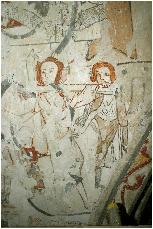
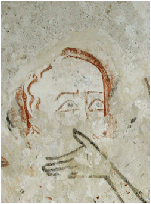
Above the Virgin and Child, in the space previously occupied by the great scrollwork tree, the new scheme was a radical move away from the past. The great geometric pattern was replaced with an intricate series of scenes, all crammed with human figures, that depicted the death and resurrection of Christ. Such schemes, known as ‘Passion cycles’ for their depiction of the Passion of Christ, were relatively common subjects for wall paintings at this period. At Lakenheath the cycle was made up of five separate scenes - the Scourging of Christ, the Carrying of the Cross, the Crucifixion, the Harrowing of Hell and Christ rising resurrected from the tomb. However, the Passion Cycle at Lakenheath is unusual in a number of ways.
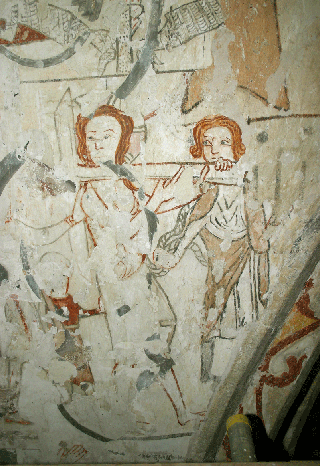
The Carrying of the Cross scene from the Passion Cycle, circa 1350. The figure of a child can be seen to the left of Christ pushing him forward.
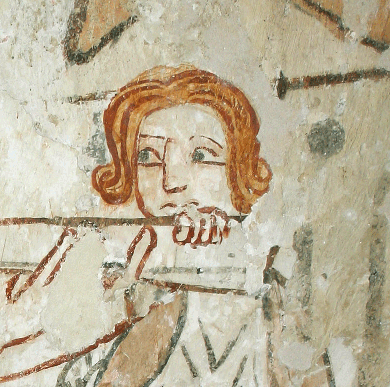
Detail from the Carrying of the Cross scene, circa 1350.
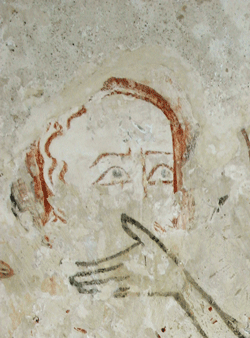
The face of St Paul, circa 1350 - all that now remains of the full length figure. The hand belongs to one of the angels from scheme 1.
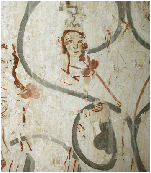
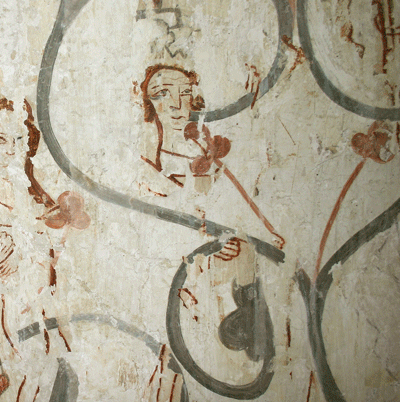
Detail of the additional crowned figure included in the Harrowing of Hell scene. It bears a striking resemblance to the depiction of St Edmund below.
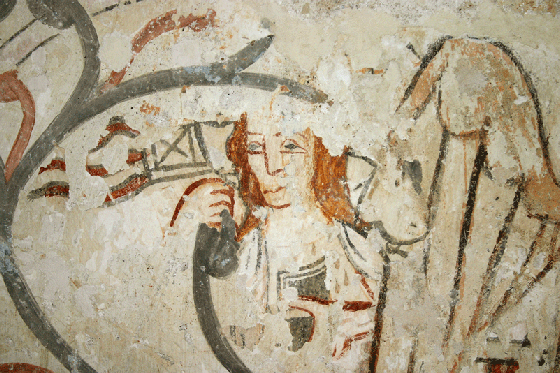
Detail showing the face of Christ from the resurrection scene, circa 1350. In his left hand he holds a book whilst his right hand clutches the Vexillium.
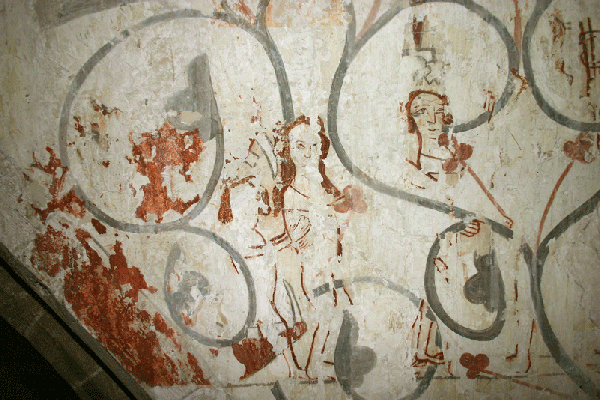
The Harrowing of Hell from the Passion Cycle, circa 1350. To the right the mysterious crowned figure leads Adam and Eve out from the mouth of Hell. The red pigment to the left is all that remains of the hell mouth - although close examination reveals sharp teeth to top and bottom.
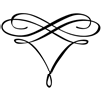
Scroll over to enlarge
Scroll over to enlarge